Editorial
Well, what can I say? Spring Downunder is about half over and it's hot, but not oppressively so. We've had a little rain, though it's still rather dry. Australia never went into recession and while there has been pain for some from the Great Global Financial Crisis, it has left most of us untouched. All in all, life is good, and November is Conference time for we researcher types. I have had two papers accepted at two conferences that are both being held at exactly the same time: one in France, the other in Sydney, Australia. Guess which one I get to present at in person? Right. Sydney. Oh well, they tell me it would be cold in France anyway—small consolation. So my colleague presents the French one and I get the consolation prize of not suffering the joys of a long international flight and spend five days on the beach in Sydney instead (the Conference venue is the Manley Pacific which is not a bad spot). If you are bored to death, have a look at our "movie" showing what we've done in the past twelve months on the UQ eResearch website. You get to suffer through my voice-over description of the action as well. Ok, back on subject...
Odds and Ends
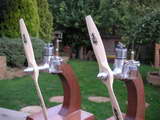
There have been a number of small but worthy little additions to old pages this month and a new entry on Page 15 of the Gallery. We have some new pictures of a disassembled engine on the Viking 2,5 page, and Dave Owen spotted a Napier Deltic quietly corroding away in a "steam park", so photos have been added to that page as well. A nice email arrived from Hi Johnson's #1 son letting me know his fameous father's full name, so the Johnson 36 page has been updated. Another reader let me know that the little Cornell Dynamic 049 had indeed been advertised in Aeromodeller and that I had the year wrong. This was only a couple of days into October and I thought an immediate update was needed to quickly get rid of wrong info, so you may already have seen the corrected page. If not, have a look as it now carries a photo of the Cornell Tutor that would have been another Dydesyne Ltd product had they not folded so quickly. Then there's numerous changes to Editorial pages, and others. Have a look through the New and Changed Index page (updated every month) to see what has been through the editor.
Guess who's 102 this year?
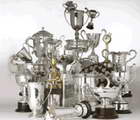
The 2009 Model Engineer Exhibition will be held at Sandown Park Racecourse (UK) from December 11 through December 13. The first was held in 1907, so this marks the one hundred and second year anniversary. As well as the exhibition of model engineering skill, trade stands, and usual award judging, the SMEE holds lectures rather like you'd find at an academic conference. Sadly, I could not find a link to what they are, but I'm sure it exists. This year, you can save £1.50 per day on the entry fee with pre-paid tickets. Click the hardware image to go to MyHobbyStore.com for more details (why do names that start with "My" get up my nose? Must be the Microsoft association thing...  )
)
NOS and NOS

Last month, I applied the term "NOS" meaning New Old Stock to the Tom Ridley's Oliver Tiger re-productions. This was totally my doing, based on what I know through looking at modern guitar makers like Fender, and Gibson. Tom has never, to my knowledge, called his engines "NOS". I labour this point because a reader who knows nothing about guitars, but a lot about antique automobiles pointed out that in that context, NOS means stock that has sat unused in some warehouse for decades and is most definitely not of recent manufacture! Well we live and learn, and I've learnt something new. I'd be tempted to say "Oops, my bad..." but I'd be using that my thing, again...
BollAero update
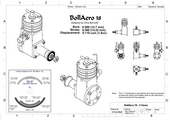
Chris Boll's BollAero 1.8 has generated a bit of interest and some actual activity. One reader has gone over the plan set minutely and found all the errors I suspected were there. Thankfully, they were all minor and none would cause anyone who has started construction to have to re-make anything. But as promised, the plan set has been updated with all corrections made. Updated sheets have had their Issue Number incremented and the nature of the change noted in the history block. Three new sheets have been added. One is a mere artsy cover sheet with a timing diagram. The others show options for the crankshaft and prop driver.
The first of these new sheets depicts the original prop driver arrangement. Chris designed it to screw onto the threaded end of the shaft on the theory that some builders would have trouble with taper fits. He wrote to me that he later fitted a grub screw which engages with a detent in the shaft to prevent the whole front end unscrewing. This would work for him as his original shaft was one-piece. I drew the shaft with a screw-in stud as this makes it simpler, stronger, and easily reparable in the event of a heavy landing. It also makes the thread-on driver more prone to coming undone. So builders who prefer the screw-on driver might consider making the threaded section integral with the shaft—especially if they don't anticipate flying the engine.
The other new sheet shows a Burford/Cox style "splined" shaft end onto which the driver is made a press fit.
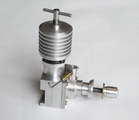
Chris also sent a photo of his new 4.4cc bar stock diesel. He reports that the engine starts easily, may be even easier to build that the 1.8cc side-port, and has flown a Junior 60 with ease. He is working through some reliability issues with the shaft at the moment, but hopes that the design might appear in Aviation Modeller International some time in the future.
Vega Confusion and a Warning
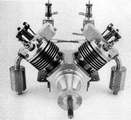
Last month, when I reported on John Bedard's Chenery V-Twin, I mentioned that John modified the heads along the lines of the Vega. About that point my brain switched off and I linked to the Harbone Vega Side-valve review. Even one second of clear thought would have made me realize that John was referring to the overhead-valve Vega V-Twin designed by David Parker. This particular Vega was serialized in the Model Engineer staring with issue 3768 dated January 3, 1986, and continuing over the next three even numbered issues. The picture here shows the Parker 9cc V-Twin as it appeared in the first part of the series. I felt so silly when John very diplomatically made me aware of this and the error on that page has now been swept under the carpet.
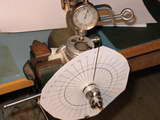
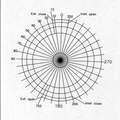
If I have any defense, it is that John Harbone did make twin cylinder side-port Vegas, and by one of those amazing coincidences we frequently see, an email arrived during October from the owner of an opposed twin Vega asking for help with timing. The owner had the engine from new, but had never run it. All Vegas were "factory run" so over time, left over oil gummed up the tappets. Wanting to run the engine, the owner removed the backplate and found himself with a lap full of timing gears and cams. Over a few emails we sorted out the basics of how he could re-time the Vega and I must stress that Torsten did all the hard work, I just gave some hints. First he profiled a cam pair to establish the valve overlap. One cylinder was then set to TDC and the cam gears juggled to set the timing to the middle of the overlap. The photos here show the timing diagram, the setup for establishing it, and for re-timing the engine.
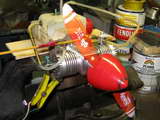
Although a flat twin, the Vega pistons share the same crankshaft pin, so piston movement is not opposed. This is not ideal for harmonic balance as all the reciprocating mass is always moving in the same direction. It also forces the power strokes to be fixed at 180° apart. Opposed movement allows them to be set 360° apart resulting in evenly spaced power strokes in the 720° two-stroke cycle. But the 180° arrangement is not that unusual and has been used in commercial products such as the Siato FS-80T. It also simplifies the crankshaft which reduces time and cost to manufacture. So Torsten then set the cams for the second cylinder at the TDC position and soon had it running. It would not hand-start, but the instructions state as much saying an electric starter is required. It was while reading the instructions that Torsten spotted a warning to the effect "..never dismantle the backcover for you will be in trouble"!
This is good advice to all, and not just four-stroke owners. I've lost count of the number of times I've seen cross-flow two-strokes reassembled with the cylinder rotated 180° making the exhaust function as the transfer and hence open before the transfer which is trying to operate as the exhaust! The result may run, but it is not a happy chappie. The moral of the story is don't, and if you do, don't be reluctant to ask for help if it all turns pear shaped.
Merc Progress
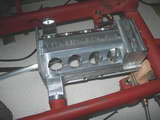
Our old mate, Brian Perkins, emailed to inform he has updated his Mercedes W 165 Grand Prix web site. New pages detail how he set about moulding his own tyres, making the spoked wheels and other mind-boggling activities. Brian is now into the really interesting bit: the engine department. As usual, he is hogging from the solid, then proceeding to make the bits look like lost-wax castings. After looking at the pictures and trying to imagine how I'd tackle the same tasks, I'm definitely going to switch to stamp collecting.
Old Watzit Identified At Last
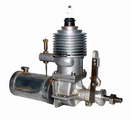
A long, long time ago, ECJ editor, Tim Dannels, sent in photos of a Watzit that had us all baffled. I know it was a long time ago because the engine in question appears at the bottom of page one of the Watzits and we are now up to page six and it's nearly full. Anyway, Tim, as executor for Roger Schroeder's Classic Engine patterns, was looking looking over the MEN website and got side-tracked to the Watzits and realized he now had the answer to one of life's mysteries. So click the picture to re-visit the item in question. I have added a "show the answer" button, but not changed the original text, so you can see how close we got in all those long ago guesses.
New Books and Magazines This Month
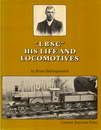
The Library underwent a quantum size increase in October, courtesy of the family of my old friend, Russ Watson-Will. The books are mostly reference material on full size aircraft and their manufacturers, but there are a couple on model engineering and Lillian "Curley" Lawrence, aka L.B.S.C. who pioneered small gauge live steam locomotives. His writing style is an acquired taste, although many regard him as The Guru from the extensive writing he did for the Model Engineer, which he referred to as the paper. Although I've made a couple of stationary steam engines, steam is not my thing. However I truly appreciate all types of model engineering so these are a welcome addition and I'm quite enjoying the story of LBSC and his locomotives. There may be a review of LBSC His Life and Locomotives in a future issue, just to be different.
While on the subject of the Model Engineer, the new editor, Dave Clark, is apparently still having trouble finding someone to take up the IC reigns. ME reportedly pays well for material, so if you have the time and talent, apply! And, yes, I've been asked, but money is not everything and I'd rather waste my time doing these pages for some reason I can't precisely figure out. Anyway, ME content has reached a low as far as my interest is concerned, so I'm dropping my subscription as of next month. The money would be better spent obtaining old ME Volumes than new ones.
Engine Of The Month: BWM
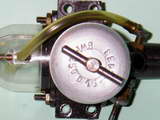
Our feature engine this month is a little known series from Germany of the early 1950's—at least, little known today in the English-speaking world; things may be different on the Continent. I've never seen one in the flesh as it were, but as usual, Adrian Duncan has one and we have dug into The Library to locate what has been written about it on both sides of the Atlantic (Model Aircraft and Model Airplane News, although the author was Peter Chinn in both cases). The manufacturer was named "BWM" and you need to look at that twice to convince yourself you are not seeing "BMW". The latter has made some very fine aero engines, but none for models!
Tech Tip of the Month
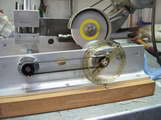
In the past, we have presented descriptions of various means employed by model engineers to produce cams used for model four-stroke engines. As the number of documented approaches increased, a Cam Making index page got added to pull them all together into some sort of order. This month, I got a nice set of shots from Chris Dunn (Australia) of a cam grinding machine he'd cobbled together. The photos Chris sent were self explanatory, so I figured I could just add a couple of words of gratuitous confusion to them and produce yet another quickie tip page. As usual it didn't work out that way, so we have a new Cam Grinding Machines page that looks at the basics of simple cam grinders, lists references for more information, and notes a fact about the follower shape and its importance in reproducing the master cam profile accurately that I'd not considered before. Click the pic, or follow the link...
 Odds and Ends
Odds and Ends
 Guess who's 102 this year?
Guess who's 102 this year?
 NOS and NOS
NOS and NOS
 BollAero update
BollAero update
 Vega Confusion and a Warning
Vega Confusion and a Warning
 Merc Progress
Merc Progress
 Old Watzit Identified At Last
Old Watzit Identified At Last
 Editorial
Editorial
 New Books and Magazines This Month
New Books and Magazines This Month
 Engine Of The Month: BWM
Engine Of The Month: BWM
 Tech Tip of the Month
Tech Tip of the Month
 Standard Stuff
Standard Stuff



 )
)











